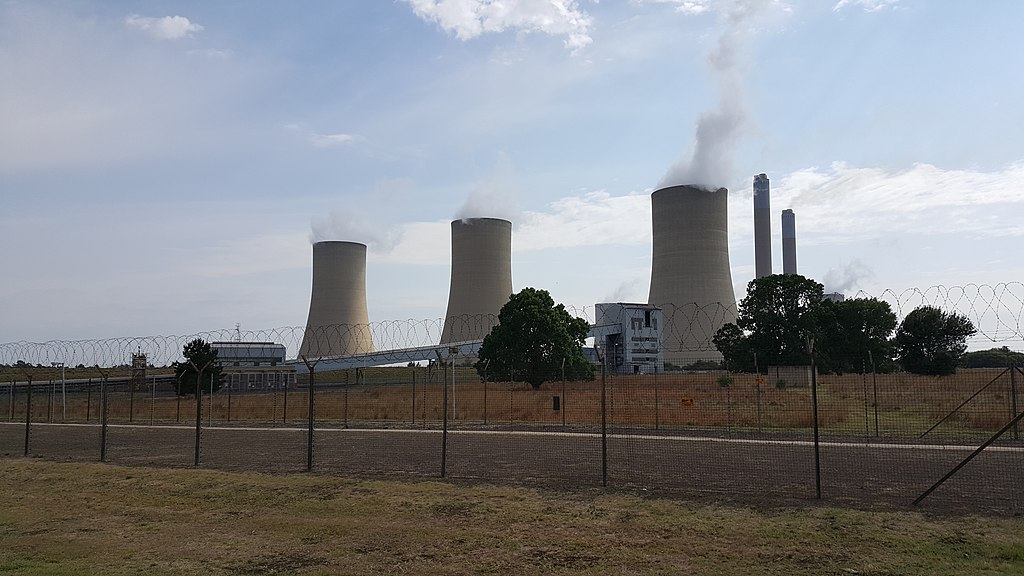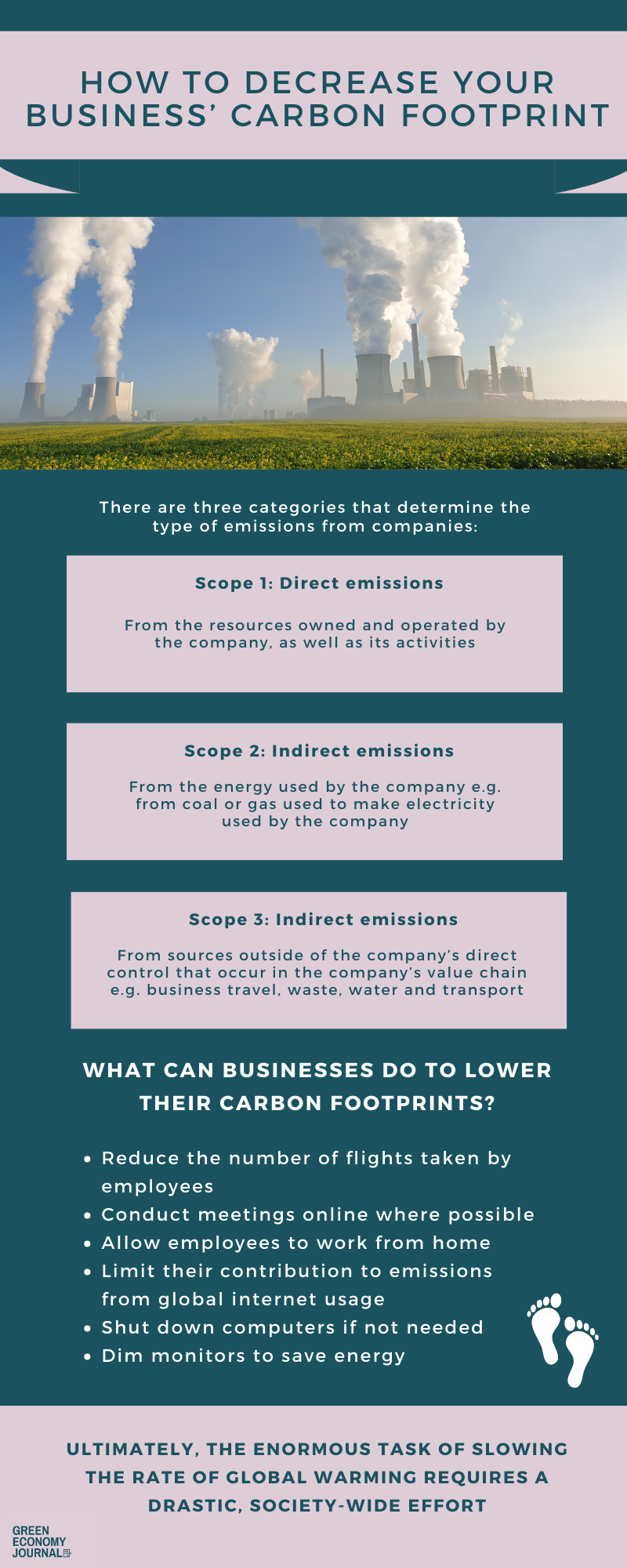How to decrease your business’ carbon footprint
A carbon footprint is the number of greenhouse gases emitted through a person, business or even a country’s activities. These greenhouse gases include carbon dioxide and methane.
Someone or something’s carbon footprint can be attributed to an event, product or service. It is measured in carbon dioxide equivalent. Carbon dioxide equivalent is a metric used to measure the emissions from greenhouse gases based on their global-warming potential. Amounts of gases are converted to the equivalent amount of carbon dioxide with the same global warming potential.
How a carbon footprint is calculated
Calculating a carbon footprint is complicated, and there are various ways to do it. Two of the most frequently used methods are the:
- Input-output model: an analyst takes the total emissions of a country or region and divides them by the emissions from one or many sectors to estimate the number of emissions of a single product.
- Lifecycle assessment: an analyst adds up as many of the emissions “pathways” as possible. This means adding up all the emissions from the various activities required to make the product, activity or other greenhouse gas emitting entity, like a country. This method is more common.
Examples of carbon footprint calculations
This is how Mike Berners-Lee explains it in his book, “How Bad Are Bananas? The Carbon Footprint of Everything”, as quoted by The Guardian:
“The true carbon footprint of a plastic toy includes not only the direct emissions resulting from the manufacturing process and the transportation of the toy to the shop: it also includes a whole host of indirect emissions, such as those caused by the extraction and processing of the oil used to make the plastic in the first place. These are just a few of the processes involved.”
Berners-Lee says that the pathways involved in calculating the carbon footprint seem endless.
“If you think about it, tracing back all the things that have to happen to make that toy leads to an infinite number of pathways. To make the point clearly, let’s try following just one of those pathways. The staff in the offices of the plastic factory used paper clips made of steel. Within the footprint of that steel is a small allocation to take account of the maintenance of a digger in the iron mine that the steel originally came from … and so on for ever.”

How to use a carbon footprint calculator
For businesses, Nedbank’s calculator is useful. It is not an automatic calculator per se, but it provides detailed information on key technical terms and concepts to help businesses carry out their own calculations.
While calculators sometimes differ depending on what information businesses need to calculate their carbon footprints, there are some universal elements. Businesses need to know their electricity, gas and water usage, according to the international climate consultancy firm EcoAct. They also require accurate information for their business travel. This includes air travel, as well as staff travel and commuting. This can be complicated to calculate. But, there are many simple calculators that can provide an insight into how much certain household and other items “cost” in terms of their emissions, like this calculator by Clever Carbon or the World Wildlife Fund.
Sage.com consultants also provide a detailed guide to calculating a business’ carbon footprint. It applies to businesses in the United Kingdom, but the broad terms and concepts are universal. CarbonFootprint.com, on the other hand, has a carbon footprint calculator that works across countries. However, with this calculator, businesses will not be able to calculate their whole carbon footprint, but they can use it to calculate some aspects of their businesses, like flights.
Unfortunately, these calculators are not designed to cater to the needs of South African businesses. The South African Fruit & Wine Initiative has an accredited carbon footprint calculator for that industry, which can only be accessed via an annual license subscription.
Why measuring carbon dioxide (CO2) is important
Carbon dioxide may be the most important of the Earth’s greenhouse gases. This is because it stays in the atmosphere much longer than other greenhouse gases, like methane or nitrous oxide. Therefore, heat trapped inside the Earth’s atmosphere by carbon dioxide stays there for longer.
The concentration of carbon dioxide in the atmosphere has risen from about 280 parts per million (ppm) since before the Industrial Revolution, some 250 years ago, to about 417 ppm today. As a result, global temperatures have risen by about one per cent since pre-industrial times. The recent rise in atmospheric carbon dioxide levels since pre-industrial times is greater than it has ever been in several thousands of years. Specifically, it is greater than the rise over the 20,000 years leading up to the Industrial Revolution.
Global warming needs to be kept below 1.5°C since pre-industrial times to avoid ever-worsening, extreme climate and weather events, according to the International Panel on Climate Change (IPCC).
Despite this warning, carbon dioxide levels reach record highs every year. In 2020, the amount of carbon dioxide in the atmosphere was as high as four million years ago. Back then, the Earth was 2-4°C hotter than today. Sea levels were 10 to 25 metres higher than they are now. This presents a grave danger to the future of human beings and the planet as a whole.
South Africa will feel the effects of this acutely. In just one example, the country’s interior provinces will be 5-8°C hotter by the end of the century. This is unless we curb global warming and slow climate change.
Sources of carbon emissions from companies
There are three categories, known as scopes, that determine the type of emissions from companies:
- Scope 1 concerns direct emissions. This includes emissions from the resources owned and operated by the company, as well as its activities.
- Scope 2 concerns indirect emissions. These emissions are those that come from the energy used by the company. This could be emissions from coal or gas used to make electricity used by the company.
- Scope 3 emissions are also indirect, but these emissions come from sources outside of the company’s direct control. These are emissions that occur in the company’s value chain, like business travel, waste, water and transport.
The internet
In addition to these sources, businesses need to keep a close eye on one of the most serious, but not widely known sources of carbon emissions: the internet. Specifically, the storing of data on internet services has a major carbon footprint. The “cloud” accounts for up to one per cent of electricity demand, and this is expected to increase dramatically over the coming decade.
The energy usage from the world’s digital consumption emits the same amount of carbon dioxide as the entire airline industry. This is because of the carbon emissions from the manufacturing and shipping of digital hardware and infrastructure, and the electricity needed to power and cool servers. The carbon footprint from the world’s internet and digital infrastructure accounts for 3.7 per cent of all global greenhouse gas emissions. This is more than all the cars on the road in the UK and the US combined.

Lowering South Africa’s carbon footprint
Greenhouse gas emissions have increased to such a degree that global warming and the resultant changes to the climate are now inevitable. The Earth will continue to warm until at least 2050, no matter what steps are taken to curb emissions, the IPCC says. But, it is not too late to slow the rate of warming to avoid catastrophic changes to our planet.
Global warming of 1.5 and 2°C will take place during the 21st century unless there are “deep reductions in carbon dioxide and other greenhouse gas emissions”, according to the IPCC.
South Africa has a huge part to play in this because, in terms of carbon emissions, the country punches above its weight. South Africa is estimated to be the 12th biggest emitter of greenhouse gases in the world. At least two-fifths of these emissions come from Eskom, the country’s state-owned electricity supplier. But, with new emissions targets, South Africa will move away from its reliance on coal more quickly than initially planned.
Eskom aims to reach net-zero emissions by shutting down coal-fired plants and replacing them with renewables by 2050. To reach net zero in time, no new oil and gas fields or coal mines should be approved by the government, as recommended by the International Energy Agency’s Net Zero report.
However, Eskom is not the only problem. Emissions from industry, agriculture and waste also form part of South Africa’s total greenhouse gas picture. Clearly, there is room for business and industry to contribute to the country’s goal of reaching net zero emissions. There have been positive developments on this front. Some mining companies have taken steps to reduce their carbon footprint.
How businesses can lower their carbon footprints
Once a business has determined what its carbon footprint is, there are a number of steps that it can take to reduce it. Businesses can reduce the number of flights taken by employees and conduct meetings online where possible. They can also allow employees to work from home more often to reduce emissions from commuting to-and-from the office.
Businesses should also be mindful of their data storage. There are many ways in which businesses can limit their contribution to emissions from global internet usage. For example, companies can make sure that they turn off autoplay when using social media. They can also avoid making video calls when audio alone will suffice and limit how often they use “reply all” when responding to emails.
If employees are away from their computers for more than two hours, they should shut down their computers. This is because computers burn energy, even when they are asleep. Employees can also dim their monitors to save energy.
Ultimately, the enormous task of slowing the rate of global warming requires a drastic, society-wide effort. The cooperation of businesses will be crucial to determining whether South Africa is up to the task.

Related Articles
Tackling climate change and health together: South Africa’s new scorecard
South Africa’s heavy coal dependence is driving a climate and health crisis — tackling both together will reap huge benefits for people and the economy.
July will be the hottest month in recorded history
“The era of global boiling has arrived”, said UN chief António Guterres, and leaders must take drastic and immediate action to limit climate catastrophe.




